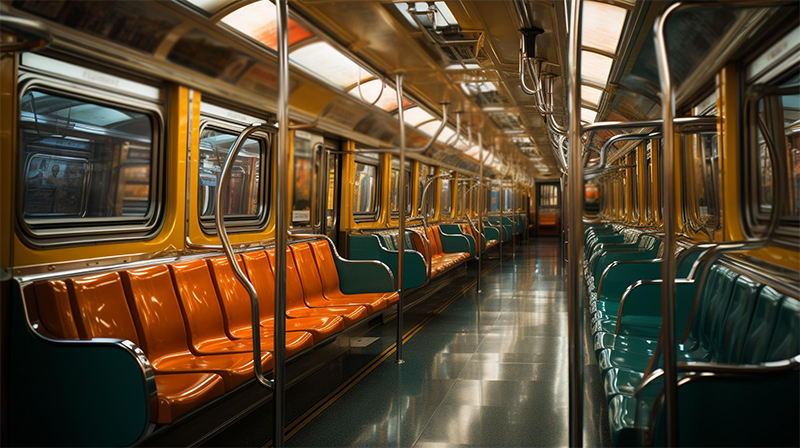The Subway Accident
In a bustling New York subway scene, commuters hurriedly fill the platform, eagerly waiting for their trains. The air is filled with a mix of conversation and the rumble of approaching trains. The platform is packed with a diverse crowd, each person immersed in their own world, oblivious to the impending tragedy.
Suddenly, chaos descends upon the scene. There is a screeching sound, followed by a jolt that sends people stumbling and falling. Panic engulfs the platform as passengers desperately scramble to safety, their faces filled with fear and confusion. The once vibrant atmosphere turns into a scene of turmoil and distress.
Emergency services rush to the scene, sirens blaring as the extent of the accident becomes apparent. People lie injured, some with visible wounds, others in states of shock. Authorities work swiftly to assess the situation, providing aid and support to those in need.
The subway accident brings the entire station to a standstill. Trains are halted, and the platform becomes a somber space filled with the sound of sirens and the urgent voices of rescuers. Concerned bystanders gather, offering assistance and comfort as the injured are attended to.
Investigations are launched to determine the cause of the incident, with the aim of preventing similar tragedies in the future. The impact of this accident lingers, serving as a stark reminder of the fragility and unpredictability of life in the bustling metropolis of New York City.
This scene has played out time and time again.
Here, we will examine the causes of accidents, the injuries they cause, and how to seek help following a subway accident.

Causes of Subway Accidents
Mechanical Failures:
Mechanical failures can be one of the leading causes of subway accidents in New York City. These failures can occur for various reasons, such as brake failure, defective rails, malfunctioning warning lights, and broken handrails.
If the brakes on a subway train fail to function properly, it can result in the train being unable to slow down or stop, leading to collisions or derailments. Defective rails can also contribute to accidents, as they can cause trains to become unstable or derail.
Malfunctioning warning lights are another mechanical failure that can increase the risk of accidents in the subway system. If these lights fail to work, it can result in trains not receiving proper warnings or passengers not being aware of potential dangers.
Broken handrails are yet another mechanical failure that can lead to accidents. Handrails provide stability and support to subway riders. If these handrails are broken or improperly maintained, passengers can lose their balance or be unable to hold on securely during sudden stops or turns.
Human Error/Negligence:
Passengers walking onto the tracks is a prime example of human error that can lead to accidents. Whether it is due to inattentiveness, intoxication, or intentional disregard for safety, such actions can have catastrophic consequences. Similarly, incidents involving passengers pushing one another on platforms or onto oncoming trains are a result of negligence and disregard for personal safety.
Out of the 1,365 subway-track incidents reported in 2022, most did not result in fatalities. Approximately 15% of these incidents were attributed to accidental falls or medical emergencies. Less than 10% were suicides or suicide attempts. [1]

Errors made by operators, such as failing to adhere to speed limits or not paying attention to signals, can lead to collisions or derailments. These errors can potentially cause harm to both passengers and subway employees.
There were 169 collisions between trains and people in 2020 — 63 fatal. [2]
Environmental Factors:
One major environmental factor that can lead to subway accidents is adverse weather conditions. Heavy rain, snowstorms, or hurricanes can cause disruptions in subway services, making tracks slippery or obstructing visibility. This can result in accidents such as train derailments or collisions.
The presence of trash, fallen leaves, or discarded objects can interfere with the functioning of the subway system, leading to equipment malfunctions or disruptions in train operations.
Fog, smog, or low light conditions can impair the visibility of both subway operators and passengers, increasing the risk of accidents due to potential misjudgments or delayed reactions.

Track Defects:
Defective rails may have structural weaknesses or faults that can lead to derailments or accidents if not promptly identified and repaired. Another issue is improper track maintenance, resulting in uneven or deteriorating track surfaces, increasing the likelihood of accidents such as train derailments or collisions.
The consequences of track defects can be severe. In addition to potential injuries or fatalities, subway accidents can cause significant disruptions to transportation services, inconveniencing thousands of commuters. They can also result in lawsuits or legal claims against subway authorities for negligence or failure to maintain safe track conditions.
Signaling Problems:
Signaling problems can often be a contributing factor in subway accidents, leading to disruptions in subway service. Signaling systems play an important role in controlling the movement of trains and ensuring safe operations within the subway network. When these systems encounter issues, it can have serious consequences for both commuters and subway authorities.
By their very nature, subway systems require a high level of precision and synchronization to maintain safe operations. Signaling systems are responsible for directing train movement, ensuring appropriate spacing between trains, and preventing collisions. When signaling problems arise, it can lead to accidents or near misses, jeopardizing the safety of passengers and subway operators.

Overcrowding or Congestion Issues:
Overcrowding and track intrusions are two significant factors contributing to subway accidents and the risk of personal injury in New York City. The NYC subway system is notorious for its crowded platforms, especially during peak hours, making it challenging for passengers to move safely and efficiently.
The lack of space and congestion can lead to accidental falls, trips, and collisions, causing injuries ranging from minor bruises to more severe fractures or head trauma.
In addition to overcrowding, track intrusions pose a significant danger within the subway system. Despite numerous safety measures in place, such as platform barriers and warning signs, individuals may still find themselves in potentially life-threatening situations by trespassing onto the tracks.
This reckless behavior puts not only the intruders at risk but also the train operators and other passengers. Even a momentary lapse in judgment can lead to catastrophic incidents, such as being struck by an oncoming train or electrocution from the electrified third rail.
Several factors contribute to the overcrowding issue. Encampments in subway tunnels have become more common, leading to restricted movement and blockages. Impatience among commuters also plays a role, as people rush onto platforms and squeeze into already crowded trains, exacerbating the congestion problem.
According to the MTA, a survey last month found over 350 people living in 29 encampments inside subway tunnels, and 89 encampments in subway stations. [3]
Common Injuries Sustained in Subway Accidents
Head and Neck Injuries:
These injuries range from minor concussions to more serious traumatic brain injuries (TBIs). Whiplash, a common neck injury, can also be sustained due to sudden acceleration or deceleration.
The causes of these injuries in subway accidents can vary. Sudden stops or jerking movements of the subway train can lead to passengers being thrown forward or backward, resulting in head and neck trauma. Collisions or derailments can also cause violent impacts, leading to severe head injuries.
The severity of head and neck injuries can depend on various factors, including the force of impact and the specific areas affected. Symptoms of head injuries can include headaches, dizziness, confusion, and loss of consciousness. Neck injuries may cause pain, stiffness, and limited range of motion.
Long-term effects of head and neck injuries can be life-altering. TBIs can result in cognitive impairments, memory loss, and difficulties with speech or motor skills. Chronic pain, nerve damage, and psychological issues like anxiety and depression can also have long-lasting consequences.

Spinal Cord Injuries:
These injuries occur when the spinal cord, a bundle of nerves protected by the spinal column, gets damaged due to the forceful impact of the accident.
Victims may experience a range of complications, such as paralysis, loss of sensation, or loss of control over bodily functions. These complications can affect multiple parts of the body, depending on the location and severity of the injury. In some cases, victims may become permanently paralyzed from the waist down (paraplegia) or the neck down (quadriplegia).
The victims may require extensive medical treatment, including surgery, rehabilitation, and assistive devices. They often face challenges in daily activities, such as mobility, self-care, and participation in work or social life. Psychological impacts like depression, anxiety, and loss of independence are also common.
Internal Bleeding and Organ Damage:
The strong impact of the accident can cause damage to vital organs such as the liver, spleen, kidneys, or lungs. Organ damage can lead to internal bleeding, decrease organ function, or cause complications such as infection or organ failure.
Internal bleeding may include:
Depending on the location and severity of the bleeding, victims may experience symptoms such as dizziness, nausea, abdominal pain, or lightheadedness.
Internal bleeding or organ damage can require immediate medical intervention, surgical procedures, blood transfusions, or other interventions to stabilize the condition. In some cases, victims may require long-term medical treatment, rehabilitation, or even organ transplants.
In August of 2022, a fifteen-year-old boy in Queens tried to climb onto the roof of an R train with three friends, only to have his arm severed when he fell onto the tracks and the train ran him over. [4]

Getting Help After a Subway Accident
Some injuries may not be immediately apparent and can worsen if left untreated. By seeking medical attention, you not only safeguard your health but also create a medical record that can serve as valuable evidence in your personal injury claim.
Take photos of the accident scene, document any visible injuries, and obtain contact information from witnesses. This evidence can be invaluable when presenting your case to insurance companies or in court.
Contacting an experienced personal injury attorney is also important to ensure your rights are protected. An attorney specializing in subway accidents can guide you through the legal process, help you understand your rights, and advocate on your behalf.
Contact Goldberg & Loren today for a free consultation to discuss your case and determine your eligibility for compensation.
Sources:
[1] Gelinas, N. (2023, April 2). NYC subway-track deaths soar, driven by social-media dares. New York Post. https://nypost.com/2023/04/02/nyc-subway-track-deaths-soar-driven-by-social-media-dares/
[2] Westfall, S. (2022, January 27). NYC subway trains kill dozens of people a year. Other countries have paid for safety. Washington Post. https://www.washingtonpost.com/world/2022/01/25/subway-global-system-platform-barriers/
[3] Rivoli, D. (2022, February 25). Dozens of encampments found inside subway system, MTA says. Spectrum News NY1. https://ny1.com/nyc/all-boroughs/news/2022/02/25/dozens-of-encampments-found-inside-subway–mta-says
[4] Chan, W. (2022, September 1). The lethal rise of ‘subway surfing’: ‘If someone slips, it’s game over.’ The Guardian. https://www.theguardian.com/us-news/2022/aug/31/subway-surfing-new-york-deaths-injuries

